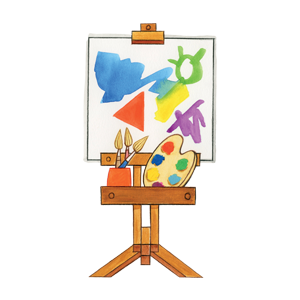Artoo is a rather unusual bear: he lives in the attic of a museum and he adores art. When he doesn’t understand a painting, he asks kids for help.He knows they have a special sixth sense for discovering the hidden meaning of things.

Artoo is a very shy bear. That’s why he only comes downstairs to look at paintings at night, when no one else is in the museum.
Artoo knows a secret: he knows that children, even very young ones, have a sixth sense for understanding the hidden meaning of things. Works of art, too.
He made a hole in the floor of his home and through it he listens to the voices of the kids who come to visit the museum during the day. What kids say is very precious. Artoo looks after their thoughts and ideas by storing their voices in his beloved jam jars.
One day, he got his friend Umberto, the museum director, to listen to the ideas he’d collected. Umberto didn’t know about the power of kids! It was Artoo who told him how good they are at explaining difficult things!
Their thoughts are so valuable that Artoo found a way to share them and spread them far and wide.
Artoo proposes a new way of approaching art and promoting the cultural protagonism of children, including those of preschool age.
An innovative approach that favours the recognition of children as citizen-authors of cultural content. Thanks to Artoo the bear:
art enters homes;
the content produced by children brings adults closer to art because of the simple, direct language they use;
- the children’s stories become a resource to be shared.


Children and families become the protagonists of a process that combines artistic and educational knowledge. Artoo:
broadens access to art: artworks enter the homes, children and families play with them, learn about them and are stimulated to go and see them;
increases cultural enjoyment: the content produced by the children talks about the works in simple, direct language and Artoo passes them on to other children and other adults, too;
creates new relations between people and cultural products: children’s stories become a cultural asset to be shared with institutions and museums.
The social impact is significant:
children are recognized as autonomous subjects and citizens capable of making their own cultural contribution;
children increase their self-esteem, develop their own expressive skills and enhance their imaginative and creative resources;
parents have the opportunity to access the content produced by their children and spend quality play time with them;
schools in disadvantaged areas, which are often excluded from cultural participation, come into contact with local institutions and see their own contributions valorised;
companies, by supporting Artoo, promote the artistic heritage of their local area and support the educational processes of schools and other learning environments.


